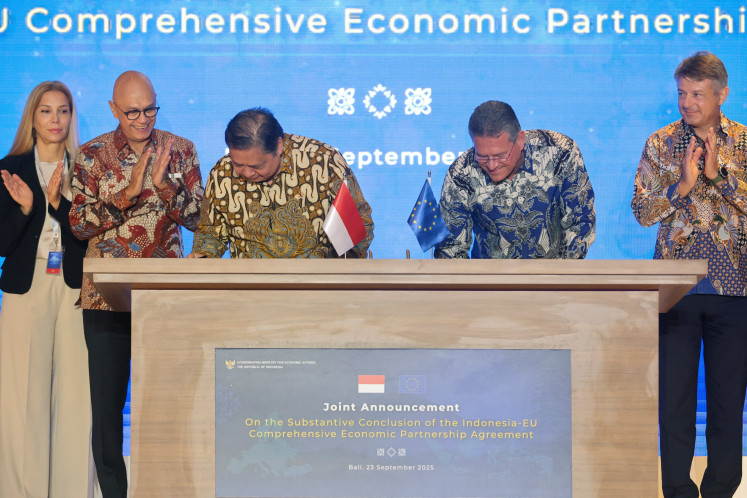Popular Reads
Top Results
Can't find what you're looking for?
View all search resultsPopular Reads
Top Results
Can't find what you're looking for?
View all search resultsKu De Ta: Sacred table surprises
Open kitchen at Mejekawi
Change text size
Gift Premium Articles
to Anyone
![Open kitchen at Mejekawi. (Courtesy of Mejekawi)" border="0" height="343" width="511"><span class="caption" style="width: 509px;">Open kitchen at Mejekawi. (Courtesy of Mejekawi)</span></span></p><p>Ku De Taâs new sacred table may serve as a place to explore the countryâs rich cuisine and offer a pleasant surprise for those searching for something different.<br><br>Known as Baliâs crème de la crème destination of connoisseurs, Ku De Ta recently introduced its latest dining venue â Mejekawi, meaning sacred table.<br><br>Ku De Ta general manager Steve Collinson said that in many ways, Mejekawi was an ode to the island that had been the establishmentâs home for more than a decade.<br><br>âMejekawi offers a progressive dining experience which adds another layer to the story of Ku De Ta by being a dining destination in its own right,â he says.<br><br>Inside, one can feel the intimate and warm atmosphere, with a glass wall giving the restaurant a 180-degree view of the Indian Ocean as well as dramatic sunsets. <br><br>On the patio outside, guests can enjoy the sunset while having cocktails before dinner. <br><br>The indoor venue is divided into three sections â a bar in the center, a dining area and a laboratory kitchen. </p><p>The lab, which serves as playground for its chefs to find inspiration for their latest creations, is equipped with high-tech toys and top-of-the-line equipment. It is also a place to host cooking classes with renowned chefs from around the world.<br><br>In the heart of the restaurant, in the dining area, attention is centered on the open kitchen, where the chefs and their team have busily prepared feasts for diners.</p><p><span class="inline inline-center"><img class="image image-img_assist_custom-307x499 " src="http://202.158.21.182/files/images2/sp-l6-bbencross.img_assist_custom-307x499.jpg" alt="Ben Cross. (JP/Intan Tanjung)" title="Ben Cross. (JP/Intan Tanjung)" border="0" height="498" width="307"><span class="caption">Ben Cross. (JP/Intan Tanjung)</span></span><br>âOur food concept is the tasting menu â seven-course and 11-course. We want to do the fine dining experience but still [make it] approachable and fun and in the open kitchen so customers can have a look and talk to the chef,â said Ben Cross, executive chef of Ku De Ta.<br><br>In their hands, traditional Indonesian dishes are transformed into art that excites not only the taste buds but also the senses. <br><br>Cross and his team combine Western cooking techniques with local flavors, picking the seasonâs best produce for their dishes. <br><br>Some of the traditional dishes, like Baliâs popular babi guling (suckling pig) and sop buntut (oxtail soup), come in completely different forms. <br><br>For babi guling, Cross cooks it for 14 hours using the French sous-vide technique in which the meat is put in a vacuum-sealed plastic bag and boiled at a precise temperature. It is then cut and crisped as desired.<br><br>The result is extraordinary â the crispiness was very surprising and the texture so succulent and clean, it almost melted in the mouth. <br><br>Served with smoked potato puree, urap (vegetables coated in coconut shreds) the dish is definitely not regular Balinese suckling pig and can only be found at Mejekawi. <br><br>âBy using Western cooking techniques, the taste is a lot cleaner. We try to choose dishes that can be tweaked with Western style cooking but still using Indonesian flavors,â Cross says.</p><p><span class="inline inline-none"><img class="image image-_original " src="http://202.158.21.182/files/images2/sp-l6-coxtailsoup.jpg" alt="Oxtail Soup. (Courtesy of Mejekawi)" title="Oxtail Soup. (Courtesy of Mejekawi)](https://www.thejakartapost.com/files/images2/sp-l6-aopenkitchen.img_assist_custom-511x344.jpg) Open kitchen at Mejekawi. (Courtesy of Mejekawi)" border="0" height="343" width="511">Open kitchen at Mejekawi. (Courtesy of Mejekawi)
Open kitchen at Mejekawi. (Courtesy of Mejekawi)" border="0" height="343" width="511">Open kitchen at Mejekawi. (Courtesy of Mejekawi)Ku De Taâs new sacred table may serve as a place to explore the countryâs rich cuisine and offer a pleasant surprise for those searching for something different.
Known as Baliâs crème de la crème destination of connoisseurs, Ku De Ta recently introduced its latest dining venue â Mejekawi, meaning sacred table.
Ku De Ta general manager Steve Collinson said that in many ways, Mejekawi was an ode to the island that had been the establishmentâs home for more than a decade.
âMejekawi offers a progressive dining experience which adds another layer to the story of Ku De Ta by being a dining destination in its own right,â he says.
Inside, one can feel the intimate and warm atmosphere, with a glass wall giving the restaurant a 180-degree view of the Indian Ocean as well as dramatic sunsets.
On the patio outside, guests can enjoy the sunset while having cocktails before dinner.
The indoor venue is divided into three sections â a bar in the center, a dining area and a laboratory kitchen.
The lab, which serves as playground for its chefs to find inspiration for their latest creations, is equipped with high-tech toys and top-of-the-line equipment. It is also a place to host cooking classes with renowned chefs from around the world.
In the heart of the restaurant, in the dining area, attention is centered on the open kitchen, where the chefs and their team have busily prepared feasts for diners.
 Ben Cross. (JP/Intan Tanjung)
Ben Cross. (JP/Intan Tanjung)
âOur food concept is the tasting menu â seven-course and 11-course. We want to do the fine dining experience but still [make it] approachable and fun and in the open kitchen so customers can have a look and talk to the chef,â said Ben Cross, executive chef of Ku De Ta.
In their hands, traditional Indonesian dishes are transformed into art that excites not only the taste buds but also the senses.
Cross and his team combine Western cooking techniques with local flavors, picking the seasonâs best produce for their dishes.
Some of the traditional dishes, like Baliâs popular babi guling (suckling pig) and sop buntut (oxtail soup), come in completely different forms.
For babi guling, Cross cooks it for 14 hours using the French sous-vide technique in which the meat is put in a vacuum-sealed plastic bag and boiled at a precise temperature. It is then cut and crisped as desired.
The result is extraordinary â the crispiness was very surprising and the texture so succulent and clean, it almost melted in the mouth.
Served with smoked potato puree, urap (vegetables coated in coconut shreds) the dish is definitely not regular Balinese suckling pig and can only be found at Mejekawi.
âBy using Western cooking techniques, the taste is a lot cleaner. We try to choose dishes that can be tweaked with Western style cooking but still using Indonesian flavors,â Cross says.
 Open kitchen at Mejekawi. (Courtesy of Mejekawi)<)
Open kitchen at Mejekawi. (Courtesy of Mejekawi)<)
Open kitchen at Mejekawi. (Courtesy of Mejekawi)
Ku De Ta's new sacred table may serve as a place to explore the country's rich cuisine and offer a pleasant surprise for those searching for something different.
Known as Bali's crème de la crème destination of connoisseurs, Ku De Ta recently introduced its latest dining venue ' Mejekawi, meaning sacred table.
Ku De Ta general manager Steve Collinson said that in many ways, Mejekawi was an ode to the island that had been the establishment's home for more than a decade.
'Mejekawi offers a progressive dining experience which adds another layer to the story of Ku De Ta by being a dining destination in its own right,' he says.
Inside, one can feel the intimate and warm atmosphere, with a glass wall giving the restaurant a 180-degree view of the Indian Ocean as well as dramatic sunsets.
On the patio outside, guests can enjoy the sunset while having cocktails before dinner.
The indoor venue is divided into three sections ' a bar in the center, a dining area and a laboratory kitchen.
The lab, which serves as playground for its chefs to find inspiration for their latest creations, is equipped with high-tech toys and top-of-the-line equipment. It is also a place to host cooking classes with renowned chefs from around the world.
In the heart of the restaurant, in the dining area, attention is centered on the open kitchen, where the chefs and their team have busily prepared feasts for diners.
Ben Cross. (JP/Intan Tanjung)
'Our food concept is the tasting menu ' seven-course and 11-course. We want to do the fine dining experience but still [make it] approachable and fun and in the open kitchen so customers can have a look and talk to the chef,' said Ben Cross, executive chef of Ku De Ta.
In their hands, traditional Indonesian dishes are transformed into art that excites not only the taste buds but also the senses.
Cross and his team combine Western cooking techniques with local flavors, picking the season's best produce for their dishes.
Some of the traditional dishes, like Bali's popular babi guling (suckling pig) and sop buntut (oxtail soup), come in completely different forms.
For babi guling, Cross cooks it for 14 hours using the French sous-vide technique in which the meat is put in a vacuum-sealed plastic bag and boiled at a precise temperature. It is then cut and crisped as desired.
The result is extraordinary ' the crispiness was very surprising and the texture so succulent and clean, it almost melted in the mouth.
Served with smoked potato puree, urap (vegetables coated in coconut shreds) the dish is definitely not regular Balinese suckling pig and can only be found at Mejekawi.
'By using Western cooking techniques, the taste is a lot cleaner. We try to choose dishes that can be tweaked with Western style cooking but still using Indonesian flavors,' Cross says.
Oxtail Soup. (Courtesy of Mejekawi)
Cross also presents Western food infused with local ingredients.
With the 11-course menu, customers will be surprised by the presentation of Balinese urutan (spiced sausage), which is transformed into a terrine and served with pickled palm hearts and sourdough crisps. It is as soft as foie gras terrine except that it is made from traditional pork sausage.
The adjustment to balance the flavor to a Western palate is also evident in the sambal chili sauce.
Cross lowers the spicy level of Balinese sambal matah (spicy condiment made with chopped raw shallots, onion, red and green chili, and dressed with home-made coconut oil and kaffir lime juice) by mixing it with kecombrang (ginger flower) to allow diners to enjoy the sauce's rich flavor without much trouble.
Although presented as a tasting menu, the seven-course satisfies the appetite just like the three-course menu, coming with a lighter sensation but exciting diners with food that has a stronger character.
In the end, the chef was very generous and introduced two more courses to the seven-course meal.
The 11-course meal was presented for curious diners, but as with the seven-course, guests mostly ended up eating more.
The food experience applies not only to mains and appetizers, but a similar technique is also used with desserts.
Will Goldfarb, Ku De Ta's executive pastry chef, presented some quirky desserts by using local ingredients. Diners were served coconut water macaron and choco bubbles made from kluwak black nut.
For the choco bubbles, kluwak was mixed with caramel-infused luwak coffee, flour and sugar ' resulting in a crunchy biscuit-type dessert topped with chocolate gelato. Although the flavor was very rich, the dessert itself was light.
'I am a rawon (beef stew) junkie so I love kluwak. I thought the rich smoky undertones would work well with chocolate and coffee,' Goldfarb explained.
Local ingredients, he said, have unexpected flavors and a richness that he loves. One thing that cannot be compared with imported ingredients is the freshness, he added.
'It takes time to understand how ingredients work and how to use them, but it is worth it. I like to understand traditional techniques and then work to apply contemporary techniques to take the best of both worlds,' Goldfarb says.










